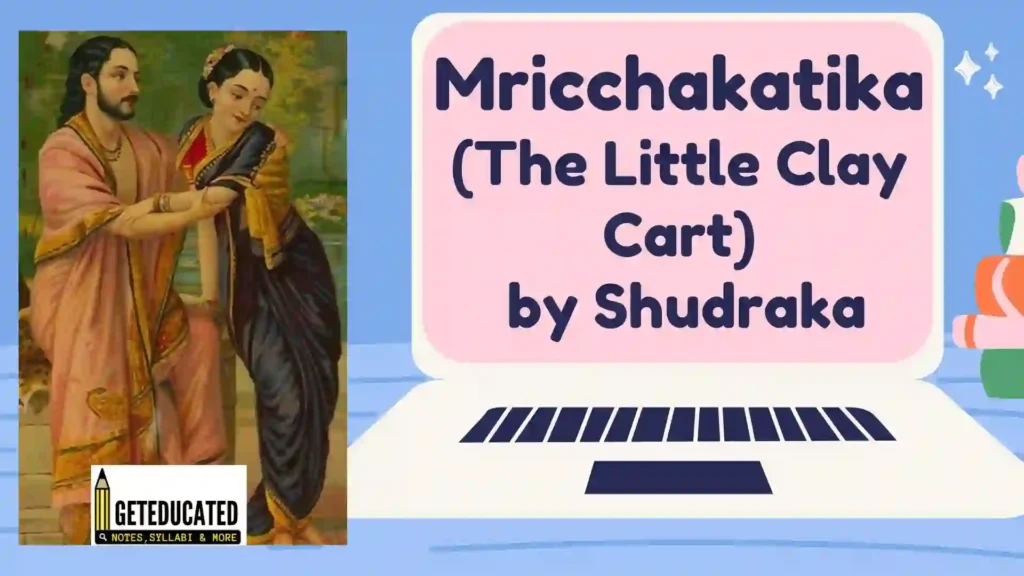
The title Mricchakatika literally means “The Little Clay Cart”. It has both literal and metaphoric significance in the play. At the same time, the title bears marks of Sudraka’s originality. A detailed study of the play reveals how the title chosen by Sudraka is both interesting and appropriate.
Sudraka, as a playwright, departed from many of the conventions of Sanskrit drama laid down by Bharata in Natyasastra. The title of his play Mricchakatika is no exception. Traditionally, a Prakarana used to be named after its Nayaka (hero) and Nayika (heroine). For instance, Malavikagnimitra is the love story of princess Malavika and king Agnimitra. Following this tradition, Sudraka could have joined the names of his Charudatta and Vasantasena in his title. However, he shows great inventiveness in conceiving the title Mricchakatika without referring to the central characters at all.
On a literal level, the title Mricchakatika refers to the clay cart of Rohasena, Charudatta’s son. The little child desires to have a gold cart as he is ashamed of his ordinary clay one. Vasantasena offers her jewellery to satisfy Rohasena’s wish. This episode of the little clay cart, although a minor one, is empirically linked to the major themes of the play.
The clay cart is basically a symbol. It is a symbol of domestic life, of ordinary humble world that Charudatta belongs to. Vasantasenaoffersto add value to it just as she adds value to Charudatta’s ordinary existence. From a different point of view, Vasantasena’s offering maybe seen as her desire to be a part of the domestic, earthly world of Charudatta. It is her way of getting her maternal yearnings fulfilled, by renouncing those objects which symbolise her isolation and childless peripheral existence. It is as if she feels that her jewels gain value when placed on that cart.
Suggested Reading :
Character Sketch of Vasantasena in Mricchakatika
The clay cart, therefore, is a metaphor of the world which Vasantasenawishes to be a part of. On the other hand, the title is a summation of the Hindu concept of seeing life as a wheel, or chakra. Charudatta’s young son has been playing with a gold cart that belonged to his friend, who takes it away. Vasantasena gives him jewels with which he can buy a gold cart. This completes the cycle. When it turns from a clay cart to a golden cart, it becomes a symbol of triumph of poverty over riches. Many such cyclic patterns are found in the plot of Mricchakatika. The fate of Aryaka, the exiled prince, who gains his throne back, the gambler who loses money and ends up receiving spiritual wealth, all follow some circle of fortune. It is as if the frame of the story is a clay cart whose wheels turn with the change in fortunes of the characters.
The title Mricchakatika is a reference to human life, its groundrealitiesrooted in an interesting world. The clay cart episode of Act VI isametaphor of universal expanse. Rohasena’s desire for the gold cart isthe eternal human yearning for prosperity. In offering her jewels to the clay cart, Vasantasena joins the group of characters like Charudatta, Madanika, Radanika, Sarbalik, who are poor but act in heroic manner. The clay cart is apparently not of any value but it serves to bring out the goodness in Vasantasena, offering her the chance to participateinthedomestic sphere of Charudatta’s life. This makes the title establish itself as both literally and metaphorically justified.

[…] The title Mricchakatika literally means “The Little Clay Cart”. It has both literal and metaphoric significance in the play. At the same time, the title bears marks of Sudraka’s originality. A detailed study of the play reveals how the title chosen by Sudraka is both interesting and appropriate. … (Read More) […]
[…] Significance of the Title “Mricchakatika” […]